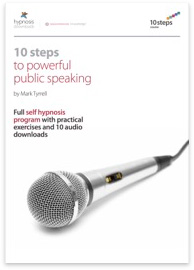A Guide to Public Speaking from Someone Who Used to Hate It
The tips, tricks and tools I used to turn presenting into something I love
 However unlikely it sounds, it's possible to turn a fear of public speaking into a love of it.
However unlikely it sounds, it's possible to turn a fear of public speaking into a love of it.Contents
- The most common public speaking fears
- How much anxiety is good for public speaking?
- How to become the master of your own anxiety
- A trick from therapy to lower anxiety levels
- How to control pre-presentation nerves
- Dogged by an ancient brain
- A 5-step mindfulness exercise to prepare your mind to respond to public speaking with calm
- Don't make this common public speaking mistake
- What to do with a difficult audience or a tough question
- 11 tips for presentation preparation and delivery
- Use humour (oh, and in the US, be sure to use humour!)
- Get up there and do it!
It's 9 am on a Monday morning, and your boss has just told you matter-of-factly that you just have to do a presentation next week - to "100 potential customers"! What's your response?
Do you:
- feel that public speaking is just part of the routine;
- relish the challenge and wonder how you can make your presentation compelling, informative, and inspiring; or
- feel you would rather die than stand up and be judged under the harsh scrutiny of an unforgiving audience?
Great presenters can transform almost any subject into one of interest or even inspiration. A friend once told me that the most entertaining and thought-provoking presentation they ever saw was about print processing! The speaker was that good!
But before we get to that level we have to deal with the little question of fear - even terror. Maybe the idea of actually enjoying public speaking seems beyond bizarre to you right now.
But it is possible to go from terrified to terrific.
Public speaking is dear to my heart because I was once one of the terrified, but now I've built a career out it (I don't like to be beaten!). At a guess, I'd say I've now presented to over 50,000 people.
In my decades as a therapist I've worked with hundreds of frightened public speakers, and you know what? Their fears (and my old ones) form common patterns.
So what exactly are people afraid of when it comes to public speaking?
See if you recognize any of these.
The most common public speaking fears
- 'Drying up' or not being able to speak
- Forgetting what you are talking about or your mind going blank
- Having the heckler from Hell
- Someone in the audience knowing more than you do
- People noticing that you're nervous
- Being so fearful that you literally can't walk on stage or speak
- The presentation being so awful and embarrassing that your social/career relationships are forever ruined
- Being asked the impossible-to-answer 'question from Hell'
- The audience talking over you or walking out
People sometimes even talk about 'dying' of fear when they step onto the dreaded stage. This may be metaphorical, but for many people it really does feel that bad.
Of course, the one element all of the above fears have in common is excessive stress. If stress is fuel, we want some - but not so much as to 'flood the engine'.
One thing I learned really early on was not to kill fear, but to use it.
How much anxiety is good for public speaking?
It may sound odd, but stress can be your friend. When presenting we need a little anxiety. At one point in my career I was presenting to so many people every week I began to notice a drop in the energy I was conveying. I needed to ramp it up a bit. But how?
It might sound strange, but I had to start self-hypnotically imagining being on a roller-coaster ride before going on stage, just to give me some adrenaline!
How to become the master of your own anxiety
Remember, stress produces energy, so a little is good. But how can you start to control the stress rather than unrealistically (and unhelpfully) trying to eliminate it altogether?
A trick from therapy to lower anxiety levels
I like to inwardly grade anxiety levels, which is something many therapists do with their anxiety clients. As soon as you start doing that, a part of you steps outside of the anxiety so that you are not just in it but observing it. The part of you that observes is not the part that is anxious.
So, if 10 is the most terrified you can be and 1 is zombie-like, I would want to be no lower than a 4 to start my presentation. I want some nerves in the initial stages, just not so many that I can't think. I then want the stress level to diminish a little as I get going, down to maybe a 3 or a 2 for the rest of my speech.
We need enough tension to give us energy, and enough calmness for clear thinking and recall. We need the right balance. But how do we achieve that balance? How do we control it?
When we breathe out, we trigger the relaxation response. This is why you may yawn more when you're stressed - it's your body's attempt to destress you by extending your outbreath. Breathing in to the inward count of five, say, and out to the count of seven will lower stress fast. So I use this to get my numbers down before I begin speaking. Try it!
Breathing down your numbers is something you can do in the moments before you begin your compelling and charismatic presentation. But what about that anticipatory anxiety hours, days, or even weeks before your big speech?
How to control pre-presentation nerves
We all do a kind of self-hypnosis whenever we strongly imagine an upcoming event and feel certain feelings. For example, if every time I imagine speaking at a conference next week I feel anxiety at the same time,I am training my unconscious mind, through repetition and association, to actually produce fear when my big day comes.
I have mentally tagged this situation as a threat so often that my emotional instincts are simply doing as they've been instructed. Sound a bell every time you feed a dog, and pretty soon the association will stick - food or no food, the dog will always salivate to the sound of the bell.
The anticipatory anxiety pattern goes something like this:
- You have a presentation coming up.
- You think about it, imagining things going wrong and feeling anxious.
- Unknowingly, you build up an association between the thought of the speech and the feeling of fear.
- You go into the actual situation and get a fear response!
Repeated often enough, this kind of 'negative mental rehearsal' will create a very close association between the emotion (fear) and the situation (the speech). It's hardly surprising that when you go into the actual situation you feel terrified!
I mentioned dogs, so let's briefly extend the canine theme.
Dogged by an ancient brain
As Ivan Pavlov showed, dogs who are repeatedly fed while hearing a bell can eventually salivate at the sound of the bell even when there's no food.
People who repeatedly feel fear coupled with imagining something, anything, find they feel fear when the situation arrives. This is the case even if the situation isn't really a threat to their physical survival, just as the sound of a bell isn't really food for the dog.
Any feeling can become accidentally or purposefully associated with any stimulus (which explains both strange phobias and fetishes). The pattern of emotional response becomes matched to an environmental pattern. A pattern match occurs, which may be vital... or may be sloppy and unhelpful.
Fortunately, pattern matches can be altered.
People can learn to associate tightrope walking, fighting in battles, or defusing a bomb with a state of psychological calm. And you can learn to change an association too.
Here's a way you can take control of the lead-up time before your presentation to train your mind to associate public speaking with calm and vital energy rather than fear.
A 5-step mindfulness exercise to prepare your mind to respond to public speaking with calm
- Find a quiet place where you know you won't be disturbed for 10-15 minutes. Close your eyes and focus your attention on your hands, imagining what they feel like when they relax and noticing they begin to feel relaxed.
- As the relaxation spreads, allow your mind to drift to a time where you felt really comfortable. Maybe a time when you were lying in the bath, listening to music, or laughing and having fun with friends.
- Begin to get a feel for the reality of this time. Notice the colours, shapes, sounds, even smells and tastes associated with this time. Notice what it's like to bring back something of the feeling of that time and let those feelings begin to build up almost as if you are back there.
- Once you have that feeling, imagine watching television and seeing yourself on the screen, taking your time, looking cool and relaxed giving that presentation. Notice what it is about 'the you on the screen' that lets you know you are relaxed and comfortable.
- Now drift into the screen and experience what it actually feels like to be speaking in that way, with similar feelings to those you had in the first memory. Spend some comfortable time doing this almost as if in a dream. When you have enjoyed this for a few minutes, open your eyes feeling refreshed and alert.
Read this over a few times to make sure you have it clear in your mind. Repeat this exercise regularly and notice the changes in the way you feel generally about public speaking.
Another simple strategy is to only imagine your upcoming speech when you feel relaxed, such as when you're lazing in the bath or breathing slowly and calmly, to set your body to feel good when you present. This is another way you can change the association you have with your speech.
If you want to make this process easier, you can use our course 10 Steps to Powerful Public Speaking.
Don't make this common public speaking mistake
When you're feeling nervous in front of an audience, it's easy to find things to reinforce that anxiety.
When I first began speaking to audiences, I was extremely sensitive to the way audience members looked. During the presentation I would try to read their mood. Were they frowning? Did they have blank expressions? Did this mean they were hostile?
If no one was smiling this would really bother me. If one person appeared friendlier than the rest I would focus just on them during my talk, to the exclusion of the others.
On one occasion early in my career I was conducting a two-day workshop with about forty people. There was a particular woman in the front row who continuously frowned at me and even occasionally shook her head!
I began to try to blank her out of my vision and was relieved that she didn't ask any questions. But at the end of the two days, as I was saying my goodbyes and packing to leave, she approached me. "Here we go," I thought.
But the issue she had with me wasn't a negative one!
I was amazed when she told me how much she enjoyed my presentations and that she had loved the training and couldn't believe how much she had gotten out of it! I almost asked if she was joking.
Ever since, I haven't tried to guess what my audience is thinking. I do my best to make it interesting and enjoyable for them, but trying to guess what what they think of me and my speech, unless it's really obvious, is a road to nowhere.
As I learned how to relax and enjoy public speaking, my perceptions began to change. What I had once seen as hostile I started to see as nervousness in the audience members. Rather than looking at them to put me at my ease, I began to work at putting them at ease.
It's amazing how a speaker can lead the mood of a whole group.
Now, let's specifically address two of the most common fears people have around public speaking: the heckler from Hell and the impossible-to-answer question.
What to do with a difficult audience or a tough question
Now, in my experience the following is so rare as to virtually unknown - but it's worth looking at.
During your presentation, if someone is being very disruptive then you will not be alone in being vexed with them. People generally behave decently during presentations. But there are a few options at your disposal for dealing with a sarcastic or disruptive audience member. Consider the following:
- At the start of your speech you can request that people raise their hand before any comments or questions, or designate a specific time for questioning such as at the end.
- If someone begins to interrupt or make asides, you can politely remind them of your opening remarks. Most people will respond instantly to this.
- If someone tells you they totally disagree with you, you can either try to refute them or open the debate up to the wider audience where, more likely than not, others will defend your position for you.
- Remember, your job is merely to present ideas and information in a compelling way, not to get into arguments with one audience member at the expense of the others. Remind them that other people are here to listen to your presentation. If they disagree powerfully it might be an emotional response they are having rather than an intellectual one. Calmly ask what evidence they have in disagreeing. Again, often you will find other audience members will present your ideas for you to the person who is disagreeing.
- If you don't know an answer, admit you don't know and promise to find out for them. You don't have to know everything. Public speaking is a chance to learn for you as well as for your audience, and there's no shame in that.
- Tell them that you would like to come back to that point.
- Ask them to come and see you afterwards for further discussion, as you have limited time and much material to cover and you have to think about the group as a whole. It may be that they don't approach you afterwards if they were merely seeking attention from an audience.
- Stick to the main points of your speech. You don't have to answer questions immediately or on the questioner's terms. If people wish to sideline, they can do it afterwards or during a break.
- Remember: It's not just about you justifying yourself to the audience. They carry half the responsibility in the situation. They are required to be polite, to listen to and absorb what you are saying, to ask relevant questions, and to know when to keep quiet. Your responsibility extends only so far.
But you do have some responsibility. We've looked at emotional preparation, but what about practical preparation for your speech?
11 tips for presentation preparation and delivery
Successful presenting is all in the preparation, and not just your emotional prep.
I always remember the following:
- To feel confident you need to be really familiar with your material. Hesitancy and constant note reading do not a good speech make!
- Become familiar with the 'signposts' of your speech and fully acquaint yourself with your content so that you can trust yourself to remember.
- Many good presenters I know use mind-mapping to prepare and memorize speech notes. It's quick and really aids memory and recall when you're up there presenting. Check out Tony Buzan's classic The Mind Map Book1 and this quick video on how to mind map.
- Rehearse out loud until you feel 'conversationally comfortable' about your material, as well as secure in the knowledge that it's 'all there'. It's a very comfortable feeling when you know you can trust your unconscious mind to deliver. (This doesn't mean you can't have your notes handy just in case! But no one wants to be read to.)
- Remember that rehearsing out loud can feel artificial; it's normal to feel a bit awkward when you practise. You'll find it actually feels much more natural when you present to a real, live audience.
- Imagine how you would present your material to just one interested person and then present it to your whole audience that way. The best speakers make you feel uniquely communicated to. You are not talking at people but with their minds.
- Use eye contact with each member of the audience in turn.
- If you use visuals, and I think some visuals are a great idea, don't give the audience too much to read. The more visual your visuals the better: illustrations, cartoons, or simple graphs work well.
- Remember, your speech is a story, even if it's about accountancy. It needs to have characters and a plot, which means a beginning, a middle, and an end.
- Vary your voice tonality and speed during your presentation. Convey energy when you need to, and slow down to 'draw them in' when it's appropriate.
- Remain human and don't try to be perfect. Research shows that demonstrating a small blunder or mishap can make you more likeable,2 especially when you are demonstrating expertise. No one likes a (complete) smartass I guess!
Another thing to bear in mind is that to feel natural to your audience you can make the odd mistake, mix up your words a little, or even forget what you were going to say next. All this happens in natural conversation so, up to a point, it's fine when speaking to a crowd. You are not a robot.
I have often been speaking to hundreds of people and momentarily forgotten what I was going to say next. It always come back. Some people are actually super impressed when you relax about momentarily forgetting, perhaps because they imagine they would be mortified if it happened to them.
And, talking of being natural... Generally in everyday conversations most of us will insert a little humour here and there. People like a little humour. So...
Use humour (but in the US, be sure to use humor!)
The use of humour in presentations can help fix an idea in people's minds as well as illuminate unexpected perspectives. But it has to be done in (what appears to be) a spontaneous way.
The first rule, which may seem counterintuitive, is to not care whether the audience laughs or not - although of course it's great if they do. If people remain silent in response to one of my little gems (very rare of course!), I may comment on the silence itself, which often gets a chuckle.
If you appear terrified when making a joke the audience may not respond as they would when you are relaxed, because you are sending mixed signals: your words say "I am being creative and funny" but your voice tone, body posture and other unconscious signals say "I am terrified!" People rely much more on these unconscious elements of your communication.
You don't have to be hysterical or some kind of stand-in stand-up, but a sprinkling of humour can sweeten your performance.
Now get up there and do it!
Ultimately, I really want you to ditch the thought or feeling How can I survive this? In exchange for How can I make this really fun and useful and inspiring for my audience? Weirdly, it's not about you but about them - your audience.
And finally, remember: Public speaking CAN be fun! And there's no exhilaration without just a little fear.
Once you've enjoyed a presentation, or even part of it, your self-confidence will get a huge boost and you'll be off and running! Give yourself the best chance by using the exercises and tips here. Good luck!
10 Steps to Powerful Public Speaking course is 50% off until 31st May 2022
Follow Mark Tyrrell's journey from a presentation panic attack to confidently speaking to an audience of 500...







